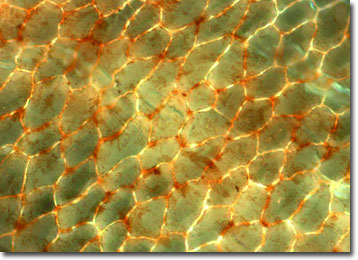Fluorescence Digital Image Gallery
Antelope Hair
Antelopes are even-toed ruminants belonging to the family Bovidae, order Artiodactyla. This family includes bison, buffalo, cattle, sheep and goats. Antelopes are herbivores, native to Africa and parts of Asia. Pronghorn antelopes, which belong to the family Antilocapridae, are native to North America, but are not true antelopes because they annually shed the outer sheath of their branched horns unlike other antelope species.

The name "antelope" comes from the Greek "antholops," meaning "brightness of the eye." Antelopes are cud chewers and typically have a short and glossy coat with a white underside. They don't have biting teeth, but tear grass from the stem by exerting pressure with the lower teeth against the upper gum pad. Food is swallowed whole and later regurgitated in small wads for thorough chewing.
Exhibiting a wide range of variations, over 100 species of antelopes have been classified. Shoulder heights can range from 12 inches (pygmy) to 6 feet (giant eland). Also, their hollow horns vary from very short to very long, straight to curved, and ringed to spiral. One uniting characteristic is that antelopes are all fast runners. They are second only to the cheetah, reaching 60 mph and they have been rumored to reach even 70 and 80 mph. Antelopes are capable of reaching such speeds because of oversized tracheas, huge lungs and hearts that lend them the power to consume and process large amounts of oxygen.
Unfortunately, many species of antelope have become endangered over the past 30 years. Aside from their natural predators including lions, leopards, and wild dogs, they also suffer from human hunting and habitat depredation. One seriously endangered species is the Tibetan antelope, also called the "chiru." These animals have been relentlessly hunted for their wool, known as "shahtoosh." The wool of one antelope can be sold in the illegal fashion market for over $40,000. Other species, such as the pronghorn antelope, are thriving. In the state of Wyoming, there are more pronghorn antelope then people.
The specimen presented here was imaged with a Nikon Eclipse E600 microscope operating with fluorite and/or apochromatic objectives and vertical illuminator equipped with a mercury arc lamp. Specimens were illuminated through Nikon dichromatic filter blocks containing interference filters and a dichroic mirror and imaged with standard epi-fluorescence techniques. Specific filters for the antelope hair were a B-2E/C and a Y-2E/C. Photomicrographs were captured with an Optronics MagnaFire digital camera system coupled to the microscope with a lens-free C-mount adapter.
BACK TO THE FLUORESCENCE DIGITAL IMAGE GALLERY
